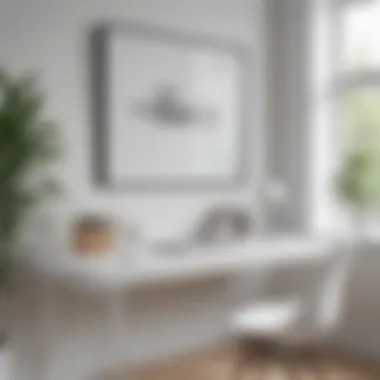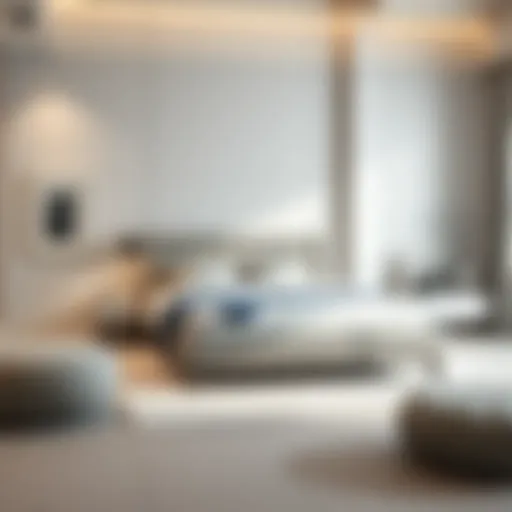The Versatile Appeal of the Simple White Desk


Intro
The simple white desk stands as an emblem of clarity and sophistication in any workspace. From minimalistic home offices to bustling corporate environments, it resonates with a sense of serenity and focus. But what lies behind this unassuming piece of furniture? In this exploration, we will dissect various dimensions that contribute to its significance, delving into its aesthetic appeal, functional design, and organizational potential.
As we pivot into discussing styles and trends, it becomes evident that the simple white desk isn't merely about what meets the eye. It’s about how it integrates into the broader narrative of furnishing spaces that inspire productivity while maintaining a sleek appearance. Thus, let’s transition into the first segment of our exploration.
Furniture Styles and Trends
Exploring Popular Furniture Styles
When considering the simple white desk, one must recognize the various styles it can embody. For instance, a Scandinavian design emphasizes clean lines, functionality, and a light palette, which resonates perfectly with the concept of a white desk. Warm woods paired with this hue can lend an inviting ambiance to the room.
Alternatively, an industrial style might play with a combination of raw metal and reclaimed wood, set against a stark white surface, creating a striking contrast that catches the eye. A carefully curated desk can indeed transform how a space feels and functions.
Here are some notable styles that often pair well with a white desk:
- Mid-century Modern: Characterized by organic shapes and smooth lines.
- Contemporary: Features bold designs that reflect current trends.
- Minimalist: Pared-down elements with less clutter, enhancing focus.
Each of these trends has its nuances, contributing to how homeowners and designers choose to approach their spaces.
Understanding Current Design Trends
At this juncture, it is crucial to examine how the simple white desk fits into the latest design trends. With the rise of sustainable materials, desks crafted from eco-friendly sources are gaining traction. A white desk made from bamboo or reclaimed wood aligns beautifully with both an eco-conscious mindset and modern aesthetics.
Additionally, multifunctionality is a growing emphasis in the realm of furniture. The ability for a desk to adapt—serving as a workspace during the day and a decorative console at night—has become increasingly desirable. Homeowners lean toward designs that accommodate work-life balance without compromising style.
"In design, less is often more, and the simple white desk embodies this philosophy, proving that functionality and beauty can coalesce seamlessly."
Practical Tips for Furniture Selection
Factors to Consider When Choosing Furniture
Choosing the right desk isn’t just about aesthetics. Practical considerations include:
- Material Durability: Look for finishes that can withstand daily wear and tear.
- Size Appropriateness: Ensure the desk fits well in the designated space without overcrowding.
- Ergonomics: Heights and angles matter; a comfortable desk encourages longer productive hours.
Understanding these elements not only assists in making a wise purchase but also enhances the overall experience of using the desk.
How to Measure and Optimize Space
To avoid cramming a massive desk into a small area, measuring the space accurately is vital. Here’s a handy checklist for optimizing your space:
- Determine available room dimensions: Measure the area where the desk will go.
- Consider traffic flow: Ensure there is enough room for movement around the desk.
- Assess additional needs: Factor in other elements like chairs or storage solutions that will also reside in the area.
By paying scrupulous attention to these aspects, one can achieve a harmonious workspace that fosters creativity and efficiency.
In summary, the simple white desk is more than a surface to work on; it’s a statement piece that embodies functionality, design trends, and personal ethos. In the following sections, we will dive deeper into how these elements can all come together effectively.
Foreword to the Simple White Desk
In today's world of work and creativity, the simple white desk has emerged as more than just a functional piece of furniture—it's a symbol of clarity and focus. This article seeks to examine why this simple design holds significance in various environments, from home offices to artistic workshops. The focus will extend beyond aesthetics; it will delve into practicality, ergonomics, and the emotional response that such an unassuming item can evoke.
The simple white desk stands out for its versatility, allowing it to blend seamlessly with various interior styles. Whether you’re a seasoned designer, a home renovator, or just someone looking to spruce up their workspace, understanding the multifaceted role of the white desk can be beneficial. Here, we’ll explore its historical roots, current trends, and the importance of intentional choices in selecting the right desk for your needs.
Historical Context
To truly appreciate the simple white desk, it’s important to consider its evolution. The concept of a desk as a work surface dates back centuries, often crafted from heavy woods with ornate detailing. However, with the advent of modernism in the 20th century, a shift began to occur. Furniture design started embracing minimalism, prioritizing function over flamboyance. By the time the 1960s rolled around, clean lines and unembellished surfaces began to dominate, paving the way for the simple white desk.
As people sought more effective ways to enhance workflow and productivity, lighter colors and simplified shapes became appealing. The white desk symbolizes a break from the past, presenting a fresh canvas that can be adapted by various users. This historical context serves as a reminder that design choices reflect broader societal changes—a dialogue between function and aesthetics.
Current Trends in Office Design


In today’s corporate and personal office designs, simplicity reigns supreme. The simple white desk fits well into this narrative of clean design. Here are a few trends shaping the landscape:
- Work-Life Balance: With many now working from home, there’s a demand for spaces that promote both productivity and relaxation. A simple white desk often becomes the centerpiece, encouraging a calm environment.
- Inspirational Aesthetics: Designers are now opting for minimal setups that keep distractions at bay. A white desk allows for a clutter-free visual experience, enabling better concentration.
- Sustainability Focus: The rise of eco-conscious consumers has prompted manufacturers to develop desks from sustainable materials. Simple white desks often feature elements made from recycled or certified materials, aligning with ethical values.
"A clean workspace fosters creativity and clarity. The simple white desk embodies both, providing a neutral backdrop to the chaos of ideas."
Additionally, within this trend, the simple white desk adapts well to various accessories and decor styles, from plants to colorful stationery, allowing personalization that keeps the space vibrant without compromising the understated elegance.
In summary, the simple white desk not only carries historical significance but also aligns with contemporary design philosophies. As we continue to navigate the evolving landscape of workspaces, its role becomes ever more profound.
Design Aesthetics of the Simple White Desk
The design aesthetics of a simple white desk play a pivotal role in defining both a workspace's visual appeal and its overall functionality. This section emphasizes how the minimalist appearance of a simple white desk can create an inviting environment conducive to productivity and creativity. A focus on design aesthetics can inform homeowners, interior designers, and decorators about making deliberate choices that enhance the character of a room without overwhelming it.
Minimalism and Modernism
Minimalism is often associated with clean lines, simple forms, and a "less is more" philosophy. The simple white desk embodies these principles perfectly. Its understated elegance promotes a clutter-free environment, which can significantly enhance focus.
On the other hand, modernism in design emphasizes the use of new materials and technology to create functional spaces. The simple white desk, while appearing basic, often integrates these modern principles by using high-quality materials such as engineered wood or durable laminates. Such desks are not just functional but also elevate the aesthetic of your space, reflecting a blend of style and utility.
Color Psychology
Color has a profound impact on mood and productivity. White is often seen as a symbol of clarity, purity, and peace. Incorporating a simple white desk into your workspace can evoke a sense of calm and encourage mental clarity.
In studies on color psychology, white is linked to promoting focus and reducing distractions. This makes it an ideal choice for environments that require concentration, such as home offices or study rooms. It's no wonder that many find a simple white desk to be a breath of fresh air in their otherwise chaotic lives.
Complementary Decor Styles
Scandinavian Influences
The Scandinavian design style is characterized by functionality, simplicity, and natural elements. When combined with a simple white desk, it creates a soothing atmosphere. The key characteristic here is the use of light wood accents and soft textiles, which contrasts beautifully against the crisp white. This approach is beneficial because it invites warmth into the workspace, avoiding the sterility that can sometimes accompany minimalist design.
A unique feature of Scandinavian style is its focus on sustainability; many pieces are crafted from renewable materials and designed to last. This makes it appealing not only for aesthetic pleasure but also for environmentally conscious decorators and homeowners.
Industrial Ambiance
Industrial ambiance brings a rugged feel to spaces, often featuring raw materials like exposed brick, metal, and wood. The simple white desk can serve as a prominent focal point in such environments, counterbalancing the roughness of industrial elements with its sleek and clean lines.
This balance can create a harmonious space that feels both creative and approachable. However, it’s essential to ensure that the simple white desk doesn't get lost amidst the more dominating architectural features. Choosing a desk with stronger visual weight can mitigate this issue, providing necessary balance.
Eclectic Mix
The eclectic mix style celebrates individuality, bringing together diverse elements, colors, and textures. A simple white desk functions uniquely here as a grounding element that pulls together seemingly disparate decor pieces into a coherent look.
One of the key characteristics of an eclectic style is its ability to reflect personal stories and preferences. The simple white desk serves not merely as a piece of furniture; it becomes a blank canvas that adapts to your unique tastes, encouraging creativity in an otherwise structured space. However, it requires careful curation to ensure cohesiveness, as too many contrasting designs could lead to visual chaos.
Functionality and Work Environment
The functionality of a workspace is pivotal to its effectiveness. The simple white desk embodies more than just aesthetics; it serves as the backbone for productivity and creativity. In delving into this segment, we explore how the desk's design, ergonomic considerations, and versatility can significantly enhance the work environment.
Ergonomics in Desk Design
When considering a simple white desk, ergonomics becomes a paramount factor. It's not about just looking pretty; it's about how the desk supports your well-being while you work. Right from the height of the desk to the arrangement of your monitors, every element plays a part in ensuring comfort. A desk that's too high or too low can lead to discomfort and potential long-term issues such as back pain or wrist strain.
An ideal arrangement encourages a neutral body position, where arms can rest naturally and feet can be flat on the ground. Moreover, adjustable desks are gaining traction, allowing individuals to alternate between sitting and standing—a fantastic way to break the monotony of prolonged periods at the desk. This adaptability, paired with a clean, white aesthetic, contributes to a work area that is not only pleasing to the eye but also conducive to enhancing well-being.
Impact on Productivity
The influence of a desk on productivity is often understated. A well-designed simple white desk commands focus—it’s like a blank canvas that invites creativity. With less clutter and distraction, one can prioritize tasks without the chaos of competing colors or designs vying for attention.
Studies show that working in an organized environment leads to improved concentration and efficiency. A simple white surface makes it easier to see everything you have at hand and declutters the mind psychologicaly. When paired with functional accessories like organized drawers or cable management systems, these desks foster a sense of control and peace, aligning perfectly with the goal of any workspace: maximizing output while maintaining a serene atmosphere.


"A clean, white desk reveals possibilities. Simplicity spurs creativity."
Versatility in Use
The versatility of the simple white desk is evident across various work environments. Whether it’s at home, in a creative studio, or a shared workspace, this desk adapts to different needs seamlessly.
Home Offices
In the realm of home offices, the simple white desk shines as a preferred choice. One key characteristic is its ability to blend effortlessly with various interior styles while ensuring functionality. Typically, this type of desk offers a spacious surface that can accommodate monitors, notebooks, and even plants, making it not just a workspace but a small oasis of productivity.
A unique feature of home offices is the personalization aspect—adding plants, artwork, or inspiring quotes can enhance the workspace's appeal. However, one might argue that without clear boundaries, the home office can become cluttered, leading to distractions. The simple white desk helps mitigate this risk by maintaining a tidy visual environment that promotes focus.
Creative Studios
For creative studios, the simple white desk serves as a versatile platform for artists and designers alike. Its clean surface allows for broad strokes of creativity without the interference of distracting elements. This characteristic fosters an attitude of exploration and innovation, essential for artistic endeavors.
However, these creative spaces can quickly become chaotic; tools, sketches, and inspiration can take over. An advantage of using a simple white desk here is also its ability to be paired with organized storage solutions, helping to maintain a certain level of order amid creative chaos.
Shared Workspaces
Shared workspaces, where collaboration is key, find the simple white desk to be exceptionally beneficial. Its neutral color promotes a less divisive ambiance, making it ideal for teamwork and discussion. The desk’s robust functionalities often support various configurations—perfect for brainstorming sessions or group projects.
Yet, it comes with its disadvantages; shared spaces can often result in wear and tear, putting strain on the desk’s surface. The simplicity of a white desk can help maintain a professional appearance, making it easier to keep clean and inviting.
In summary, the simple white desk exemplifies how functionality, ergonomic design, and versatility contribute to an enhanced work environment, catering to the diverse needs of users across different contexts.
Material Considerations
When considering a simple white desk, the choice of material plays a significant role in its overall look, feel, and functionality. Materials are not just structural elements; they influence maintenance, durability, and how they fit into one’s decor scheme. The decision-making process around materials can also reflect personal values, such as sustainability and functionality.
Wood vs. MDF vs. Laminates
When it comes to selecting a material for your simple white desk, a few options often top the list: solid wood, MDF (Medium Density Fiberboard), and laminates. Each of these materials has unique traits that cater to different needs and aesthetics.
- Solid Wood
Solid wood desks are timeless. They bring warmth and character to any space. They are also quite durable, often lasting decades if cared for properly. However, prices can vary widely based on the type of wood, and real wood might need more maintenance, like oiling. If someone prefers a more rustic or traditional style, solid wood can be the way to go. - MDF
MDF is an engineered product that uses wood fibers and adhesives. It’s more affordable than solid wood and allows for a smoother finish, which is ideal for a sleek white desk. It's less sensitive to moisture than solid wood but may lack the durability. If you're on a budget or need a lightweight option, MDF could work well. - Laminates
Laminates offer a synthetic alternative. They are often less expensive than both solid wood and MDF and resistant to scratches and stains. However, the look and feel might not resonate with those who really value authenticity. For someone aiming for a clean, modern aesthetic without breaking the bank, a laminate finish might hit the sweet spot.
Sustainability and Eco-Friendliness
Sustainability is more than just a buzzword. It’s becoming a crucial factor in home and office furnishing decisions. The material you choose can significantly impact the environment.
Eco-friendly Options:
- Reclaimed Wood: Rediscovering old wood minimizes waste while offering a rich history to your space.
- Bamboo: This renewable resource is durable and aesthetically pleasing, plus it grows quickly compared to traditional timber.
- Low-VOC Finishes: If opting for a manufactured desk, look for low-VOC (volatile organic compounds) finishes. These are less harmful to indoor air quality.
Not only does eco-friendliness matter from an environmental standpoint, but it also can carry a good amount of introspection for the owner. Choosing sustainable materials often means supporting ethical manufacturing practices and promoting a healthier planet.
"The choice of materials reflects one's values and priorities; it can transform your workspace into a sanctuary of productivity, balance, and positive energy."
All in all, delving into the material considerations when selecting a simple white desk can yield surprising insights. It does not only affect functionality and aesthetics but is also a statement of personal ethics and style. To make the best decision, one ought to weigh the benefits of each material type against personal preferences and needs.
Choosing the Right Simple White Desk
Choosing the right simple white desk is not just a matter of aesthetics; it’s essentially about finding a balance between function and style that suits one's unique workspace needs. A desk is often the centerpiece of your office or home, and its impact goes beyond mere appearance. It can influence your productivity, creativity, and even your mood. In this section, we'll break down how to assess personal needs, consider budget constraints, and optimize your space effectively.
Assessing Personal Needs
Before diving into desk shopping, it’s crucial to reflect on your personal needs. Think about your work habits and the type of tasks you frequently undertake. Do you primarily use a computer, or is your work more hands-on with sketches and notes?
- Task Orientation: If you spend long hours on the computer, prioritize ergonomics. Look for a simple white desk that supports good posture; this might mean a height-adjustable option. For creative tasks, ensure there’s enough surface area to spread out materials.
- Storage Requirements: Some folks have a slew of paperwork, while others might favor a cleaner workspace. Consider if you need drawers or open shelving. A desk with built-in storage can save you from clutter while maintaining the minimalist aesthetic of white.
- Personal Style and Feel: How do you want your workspace to feel? Is it an inviting place or just a functional area? Your desk should resonate with your personal style while also allowing you to achieve your goals comfortably.
Budget Considerations


Setting a budget is an important step in your desk selection process. The market has a wide range of prices, and it’s tempting to splurge, especially on trendy pieces. However, identifying what you value can help avoid buyer’s remorse.
- Know Your Price Range: White desks can range from affordable ready-to-assemble options to custom-built pieces. Determine how much you’re willing to allocate.
- Quality Over Quantity: Sometimes, investing a bit more upfront on a durable desk pays off over time. A high-quality desk not only lasts longer, it may also be more comfortable and visually appealing. Look for solid materials rather than flimsy alternatives.
- Sales Opportunities: Keep an eye out for sales or promotions. Black Friday, summer sales, and other seasonal discounts can be a goldmine for those on a budget.
- Consider Resale Value: If you’re eying a more expensive desk, think about its potential resale value. Certain brands hold value better than others, and if you ever choose to upgrade, a sought-after model can fetch a decent price.
Space Optimization Techniques
Even a simple white desk can become a powerful tool for maximizing your workspace if you know how to make the most of it. It’s all about positioning and organization.
- Placement Matters: Assess your room layout. Is natural light abundant in one area? Align your desk to take advantage of that light for a refreshing work atmosphere.
- Vertical Space: Don’t just look at your desk surface; think vertically too. Use wall shelves to store books or decor items, creating a streamlined look while keeping the desk itself uncluttered.
- Cable Management: Nothing spoils a clean look faster than tangled cords. Use cable clips or a cable box to conceal wires, maintaining that pristine white surface.
- Personal Touches: Well-placed decorations, like a simple plant or a framed picture, can break up the starkness of white without overwhelming the design. Just make sure they suit the functionality of your workspace.
Maintenance and Care for Simple White Desks
When it comes to ensuring a simple white desk remains a center of productivity and aesthetic charm over time, maintenance and care are absolutely pivotal. A desk, while being a functional piece of furniture, also serves as a canvas for creativity and organization. This portion of the article delves into vital cleaning techniques and strategies to prevent damage, guiding homeowners, interior designers, and decorators in maximizing the longevity and appeal of their desks.
Cleaning Techniques
Cleaning a white desk may seem straightforward, yet employing the right techniques can enhance both its appearance and longevity. Here are a few proven methods:
- Soft Cloth and Water: For routine cleanings, a soft, lint-free cloth dampened with water will often do the trick. Gently wipe down the surface, making sure to avoid any abrasive materials that could scratch.
- Mild Soap Solution: In cases of stubborn stains or spills, a mixture of mild soap and warm water works wonders. Using a soft sponge, you can tackle those markups without the risk of damage.
- Magic Erasers: These handy tools can be lifesavers for minor scuff marks. However, it's best to use them sparingly and test in an inconspicuous area first; too much friction may lead to unwanted dullness.
- Avoid Harsh Chemicals: Strong solvents or abrasive cleaners can strip away the finish of your desk, leading to long-term damage. Stick to gentle products that are safe for wood or laminate if you want to keep the white desk looking fresh.
Regular upkeep, ideally on a weekly basis, is advisable to maintain the allure of the desk. A clean desk is not only more enjoyable to work on but can also inspire enhanced focus and productivity.
Preventing Damage
Just as vital as cleaning is the prevention of damage. A proactive approach can save homeowners from costly repairs or replacements in the future. Here are a few effective strategies to consider:
- Use Coasters: Placing drinks directly on a white desk can lead to unsightly rings or stains. Utilizing coasters helps mitigate this risk. Consider something stylish to harmonize with your decor!
- Avoid Direct Sunlight: If your desk sits in a sunlit area, consider drawing shades or curtains to shield it from prolonged UV exposure. Sunlight can warp or yellow the finish over time, diminishing its elegance.
- Regular Repositioning: If you can shift your desk periodically, it can even out wear from foot traffic or sunlight exposure. This keeps the desk looking uniform and can help avoid unwanted fading.
- Manage Clutter: A tidy workspace goes a long way in preventing scratches or dents from items that are carelessly strewn about. Invest in desk organizers or storage solutions to keep items in check.
"An ounce of prevention is worth a pound of cure."
Maintaining a simple white desk is not merely about appearance; it aligns with a philosophy of care for the overall environment in which you work and create. With consistent attention to cleaning and damage prevention, the desk can sustain its charm, offering a continuous backdrop for creativity, productivity, and thoughtful organization.
The Future of Workspace Design
Looking ahead, the future of workspace design is set to become a tapestry of innovation intertwined with traditional elements. The simple white desk stands as a silent yet powerful player in this transformation. Its minimalist design resonates not only with aesthetics but also defines functionality as the boundaries between work and life continue to blur. As more people work remotely or in shared environments, having a versatile desk makes a statement about their values and aspirations in workspace organization.
Evolving Aesthetic Preferences
As we dive deeper into the design principles shaping the work environment, it becomes evident that aesthetic preferences are evolving. No longer confined to the rigid structures of past norms, modern aesthetics lean toward flexibility and personalization. The cheery charm of a simple white desk provides a canvas where creativity can bloom. Its clean lines and smooth surface invite thoughtful arrangement—think curated books, a lively plant, or even a touch of artwork.
In homes and offices alike, today’s consumers are seeking to create spaces that reflect their personalities. This trend nudges designers to embrace equilibrium between comfort and style. As part of this transition, the simple white desk encapsulates elegance while promoting calmness, a key element in reducing stress. Quick notes or a brilliant idea can be penned down on its unmarred surface, making it an ideal spot for unencumbered thought.
"A workspace that embraces personal expression can nurture creativity like no other."
Technology Integration
No conversation about the future workspace is complete without considering technology's role. The simple white desk, adaptable in nature, is positioned as a great contender for smart integrations. Think about wireless charging mats, built-in USB ports, or even adjustable features that promote standing while working. These functionalities not only enhance user experience but also speak to a growing awareness of health and productivity.
The paths are not just paved for tech-savvy millennials; even traditional spaces are beginning to embrace these advances. Smart pens, ergonomic setups, and synchronized devices can be seamlessly incorporated into the design of a white desk, making it a central hub of productivity.
In the journey forward, technology is shaping our daily dynamics. Desks that adapt to various needs, from online meetings to brainstorming sessions, become instrumental in maximizing not just efficiency but well-being.
Epilogue
The conclusion of this exploration into the simple white desk serves several key purposes. It encapsulates the essence of why this seemingly ordinary piece of furniture holds a multitude of implications for personal and professional spaces alike. From its aesthetic appeal to its functional capacity, the simple white desk emerges not merely as a workstation but as an integral element in the landscape of modern workspace design.
Recap of Key Points
In revisiting the main themes of this article, it's clear that the simple white desk is much more than a basic surface to place your laptop.
- Historical Context: It’s important to understand its evolution from traditional designs to today's minimalist trends.
- Design Aesthetics: We touched on how minimalism and color psychology play significant roles, as a white desk can evoke a sense of calm while also providing a blank canvas for creativity.
- Functionality and Work Environment: Ergonomics and productivity factors brought to light how a desk layout can influence output, showcasing its versatility across different environments like home offices and creative studios.
- Material Considerations: The choice between wood, MDF, or laminate contributes to sustainability and style.
- Choosing and Maintaining Your Desk: Careful thought about personal needs, budgets, and maintenance ensures that your simple white desk remains both stylish and functional.
Final Thoughts
To wrap it up, as the traditional office space continues to evolve, the simple white desk stands at the forefront, embodying timelessness and adaptability. The decision to incorporate such furniture is not merely a matter of aesthetics; it's about creating a productive environment tailored to individual needs. Whether you are a homeowner, a designer, or someone who simply values a clean and organized workspace, understanding the significance of a simple white desk can pave the way for a more efficient and enjoyable working life.
As the lines between home and work blur, investing in the right desk might just be the smartest move you can make for your personal sanctuary or office hub.















